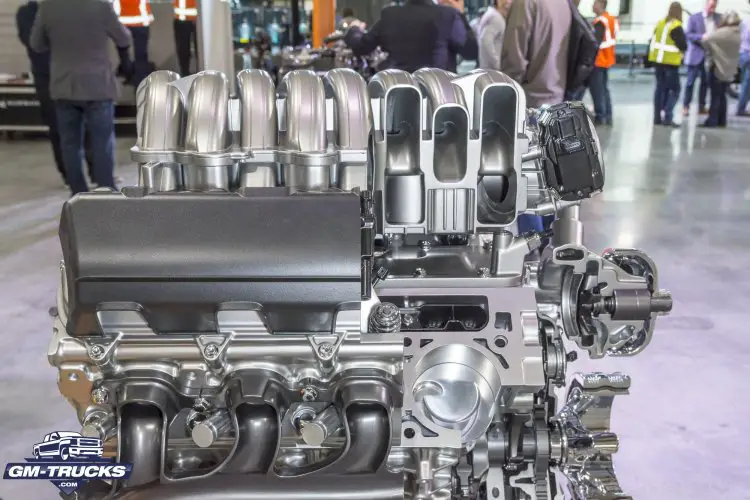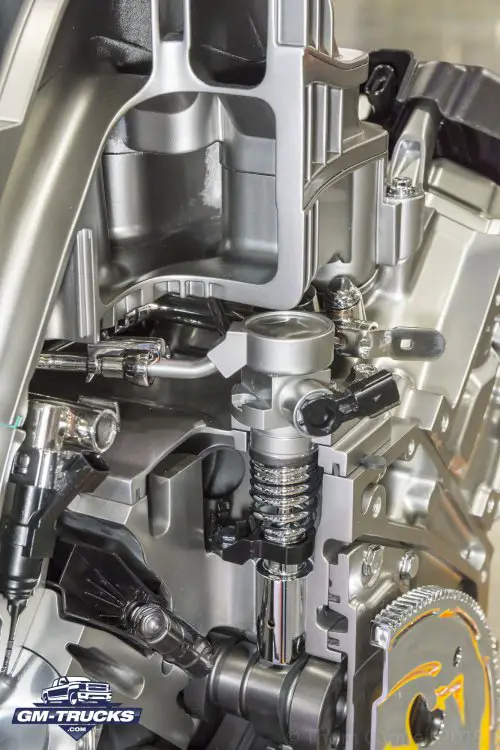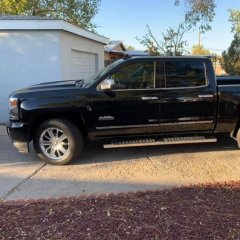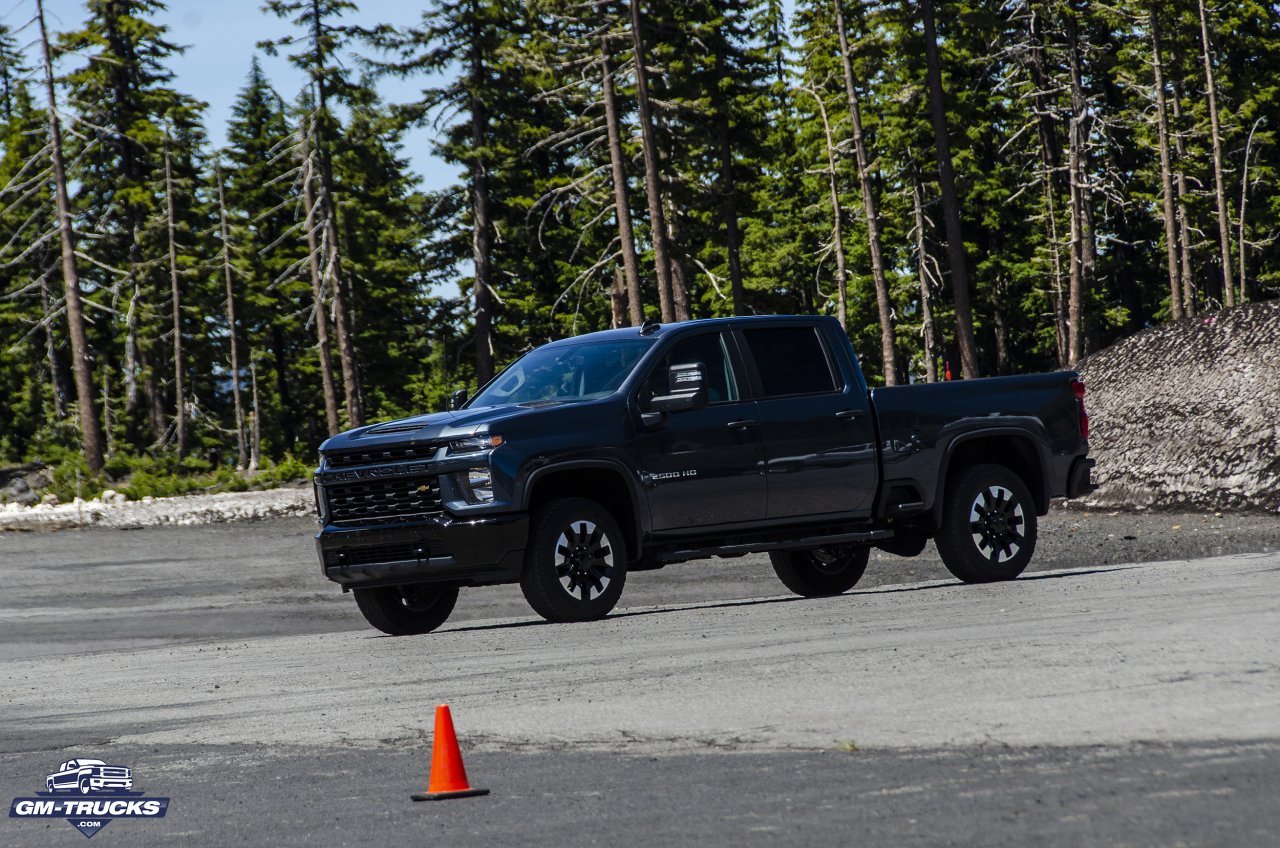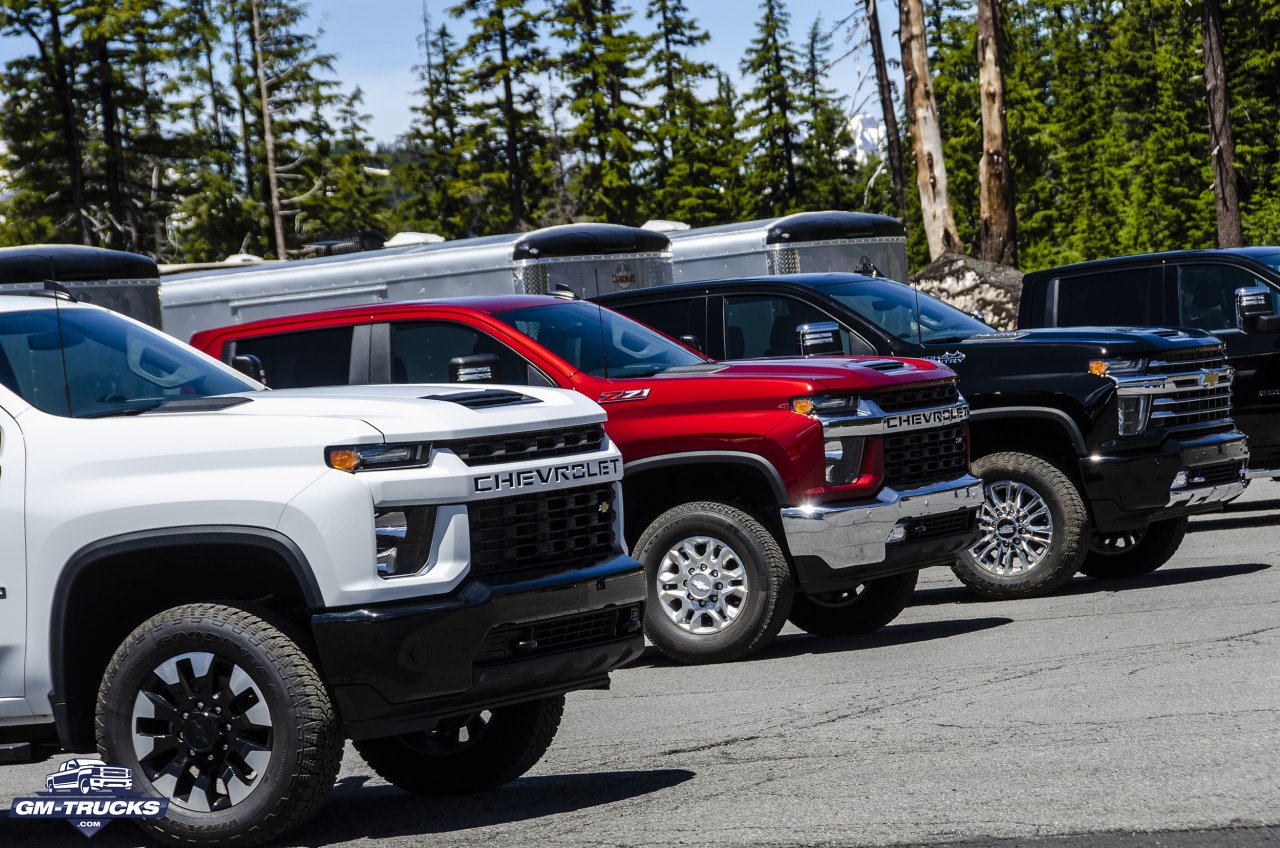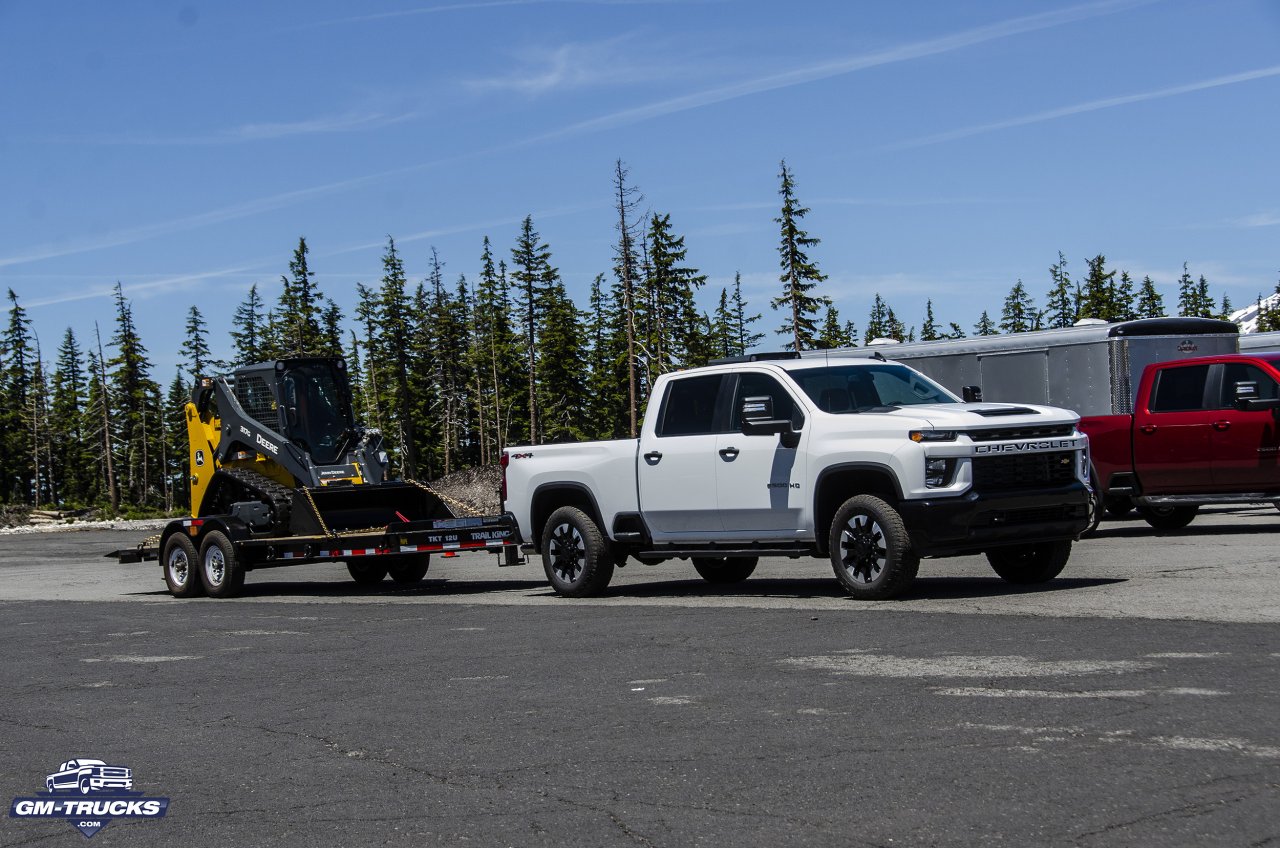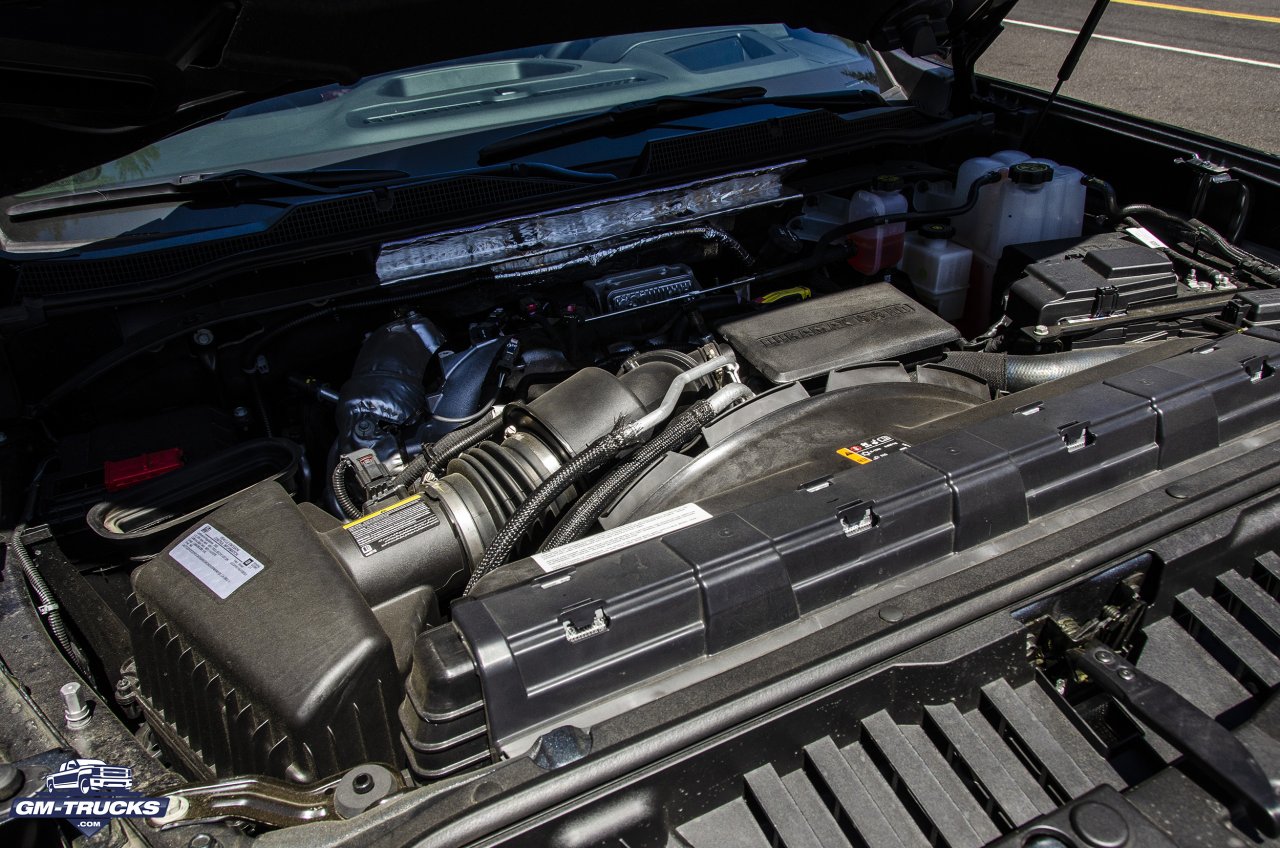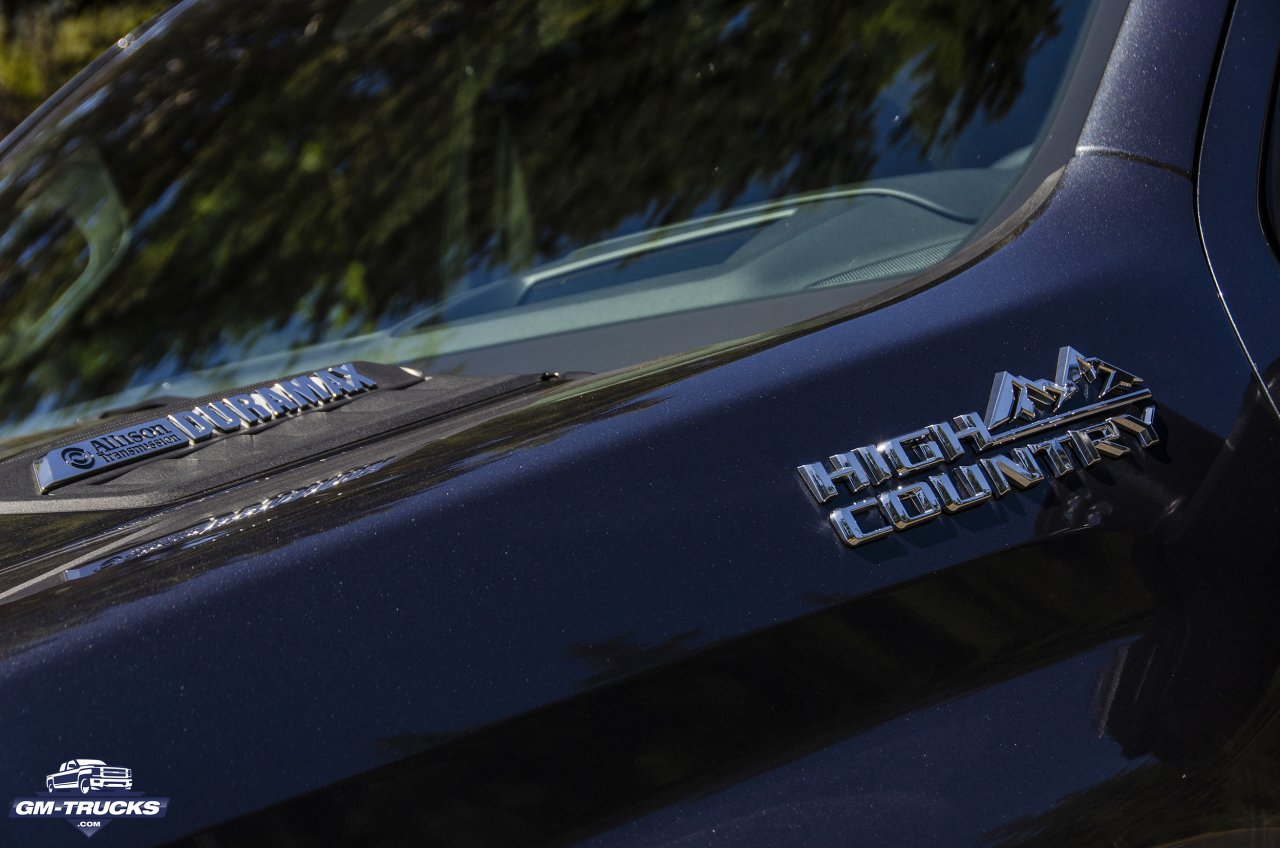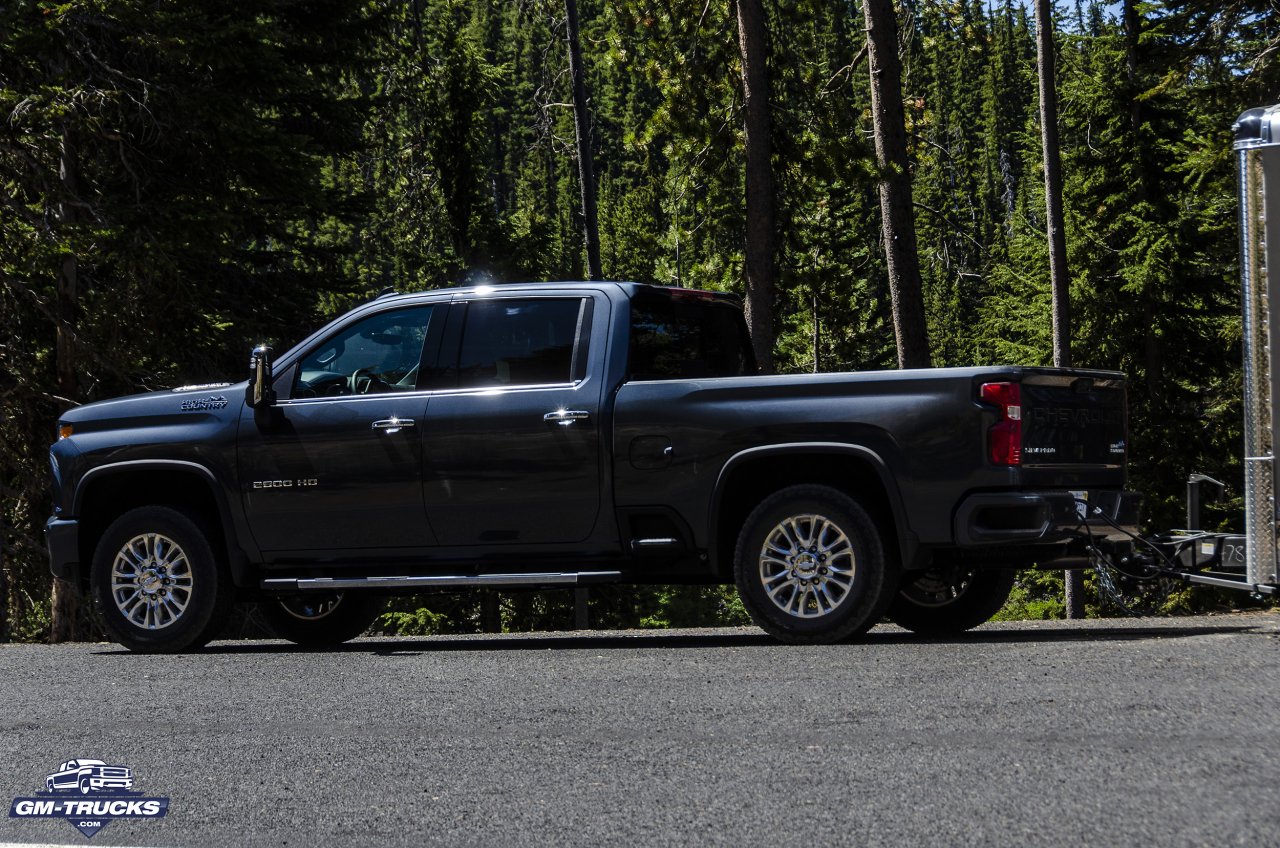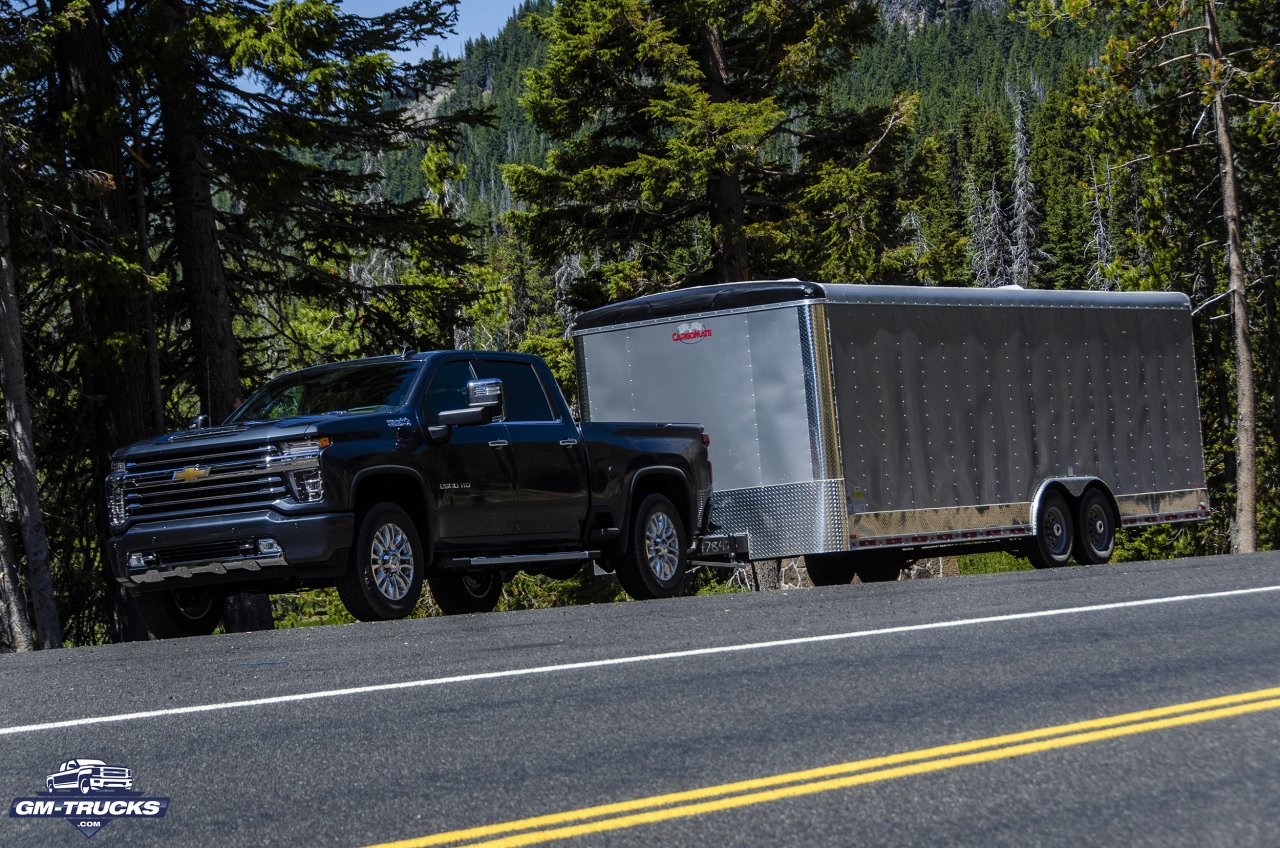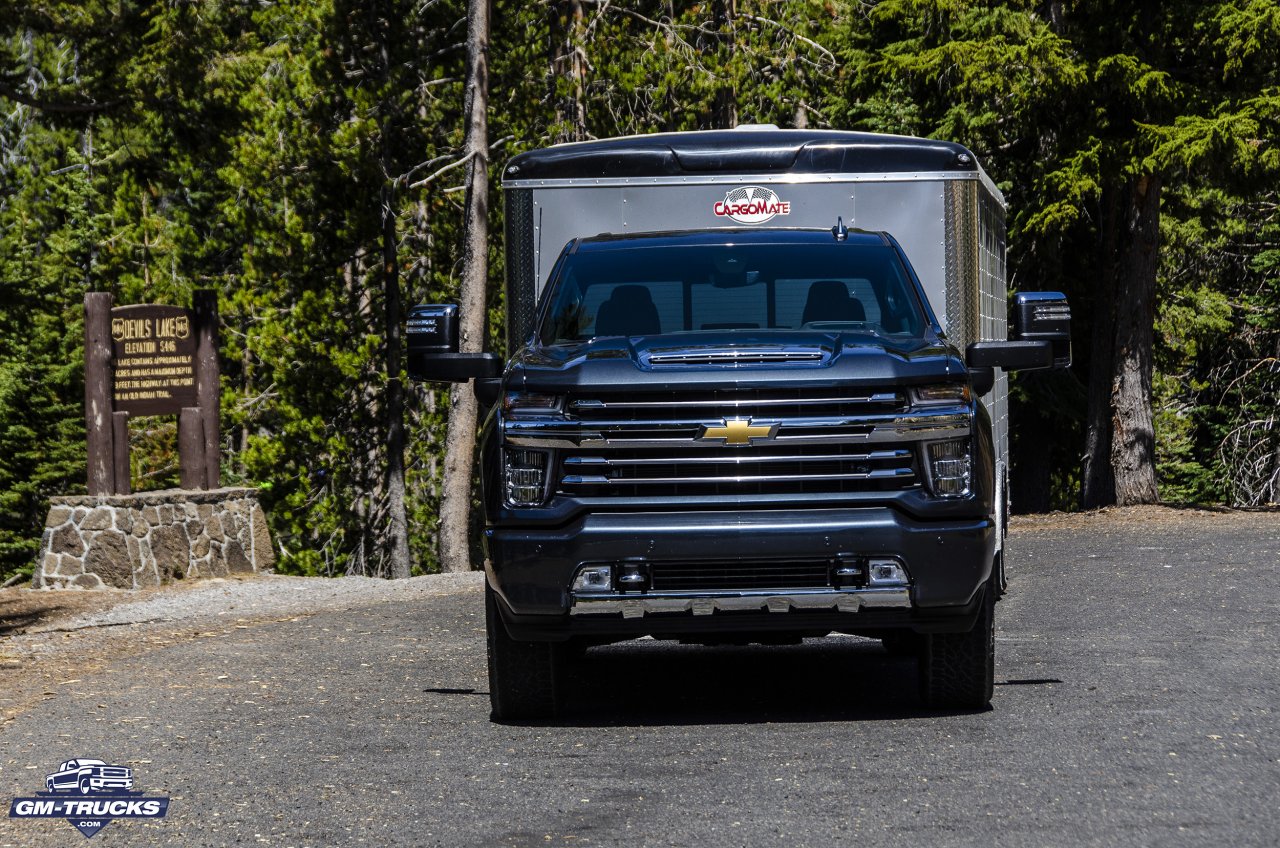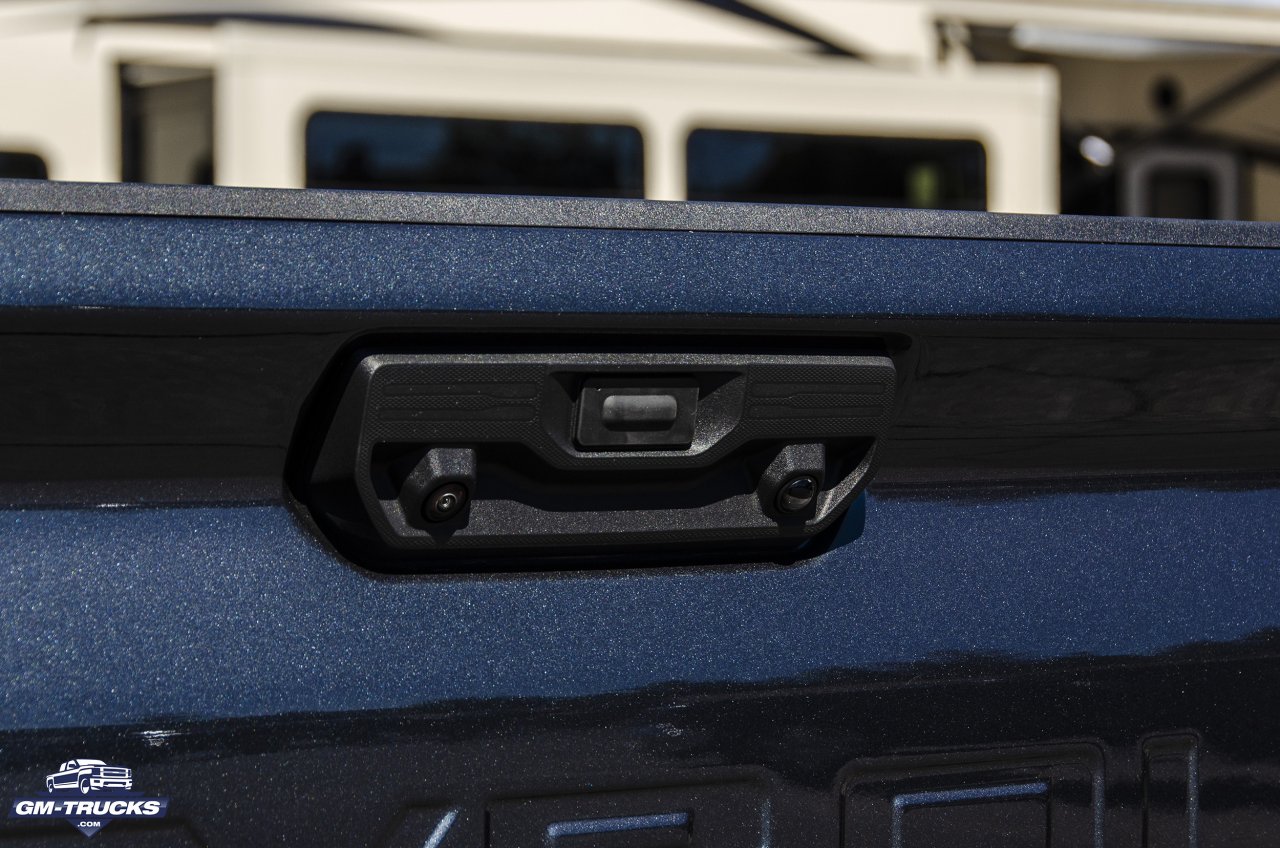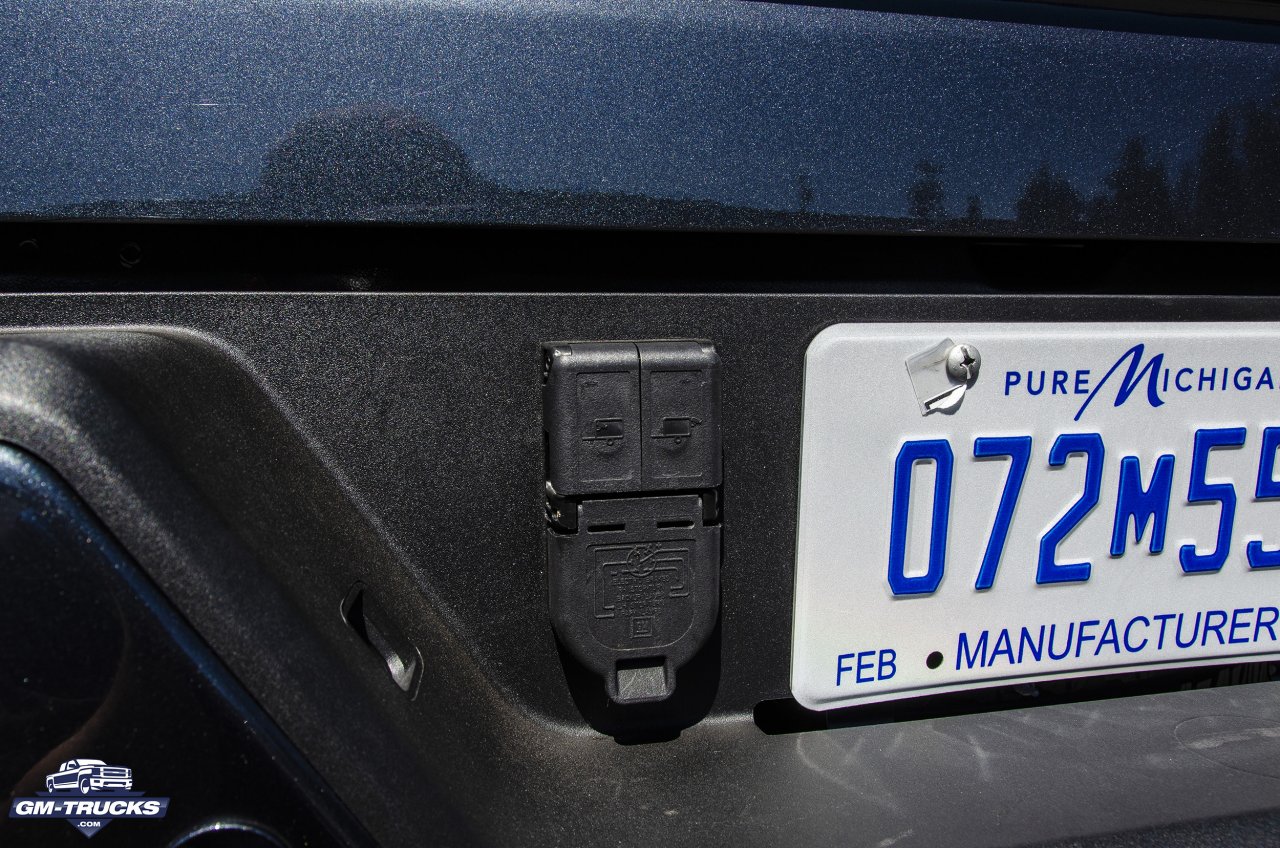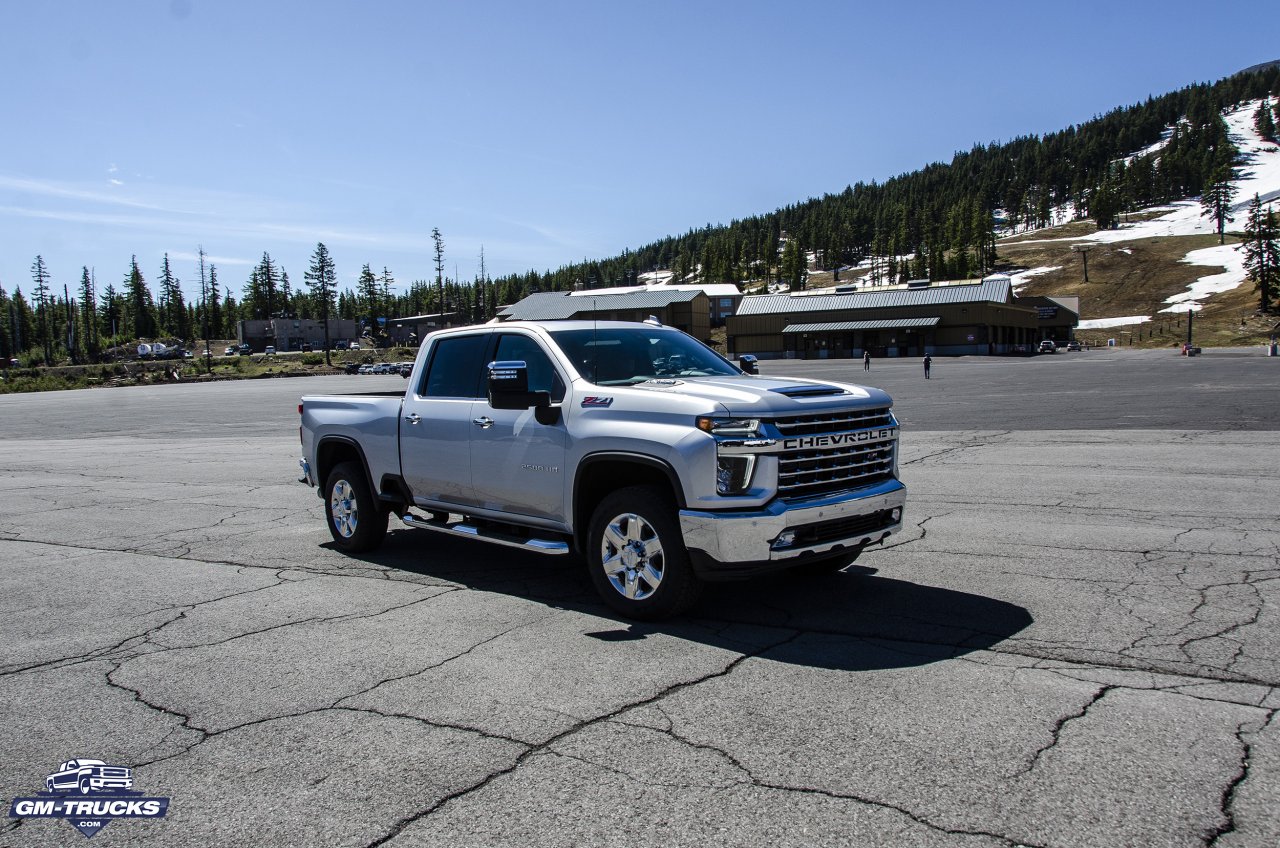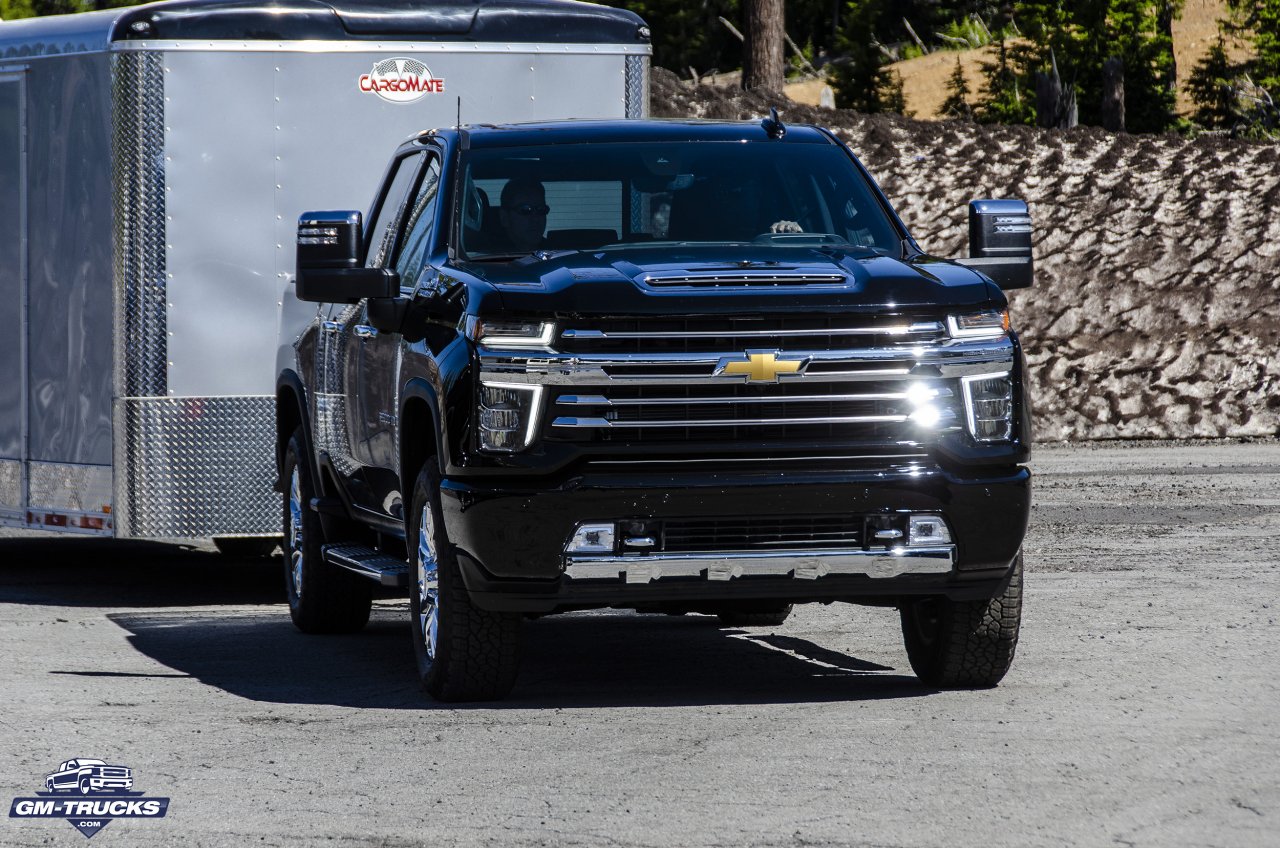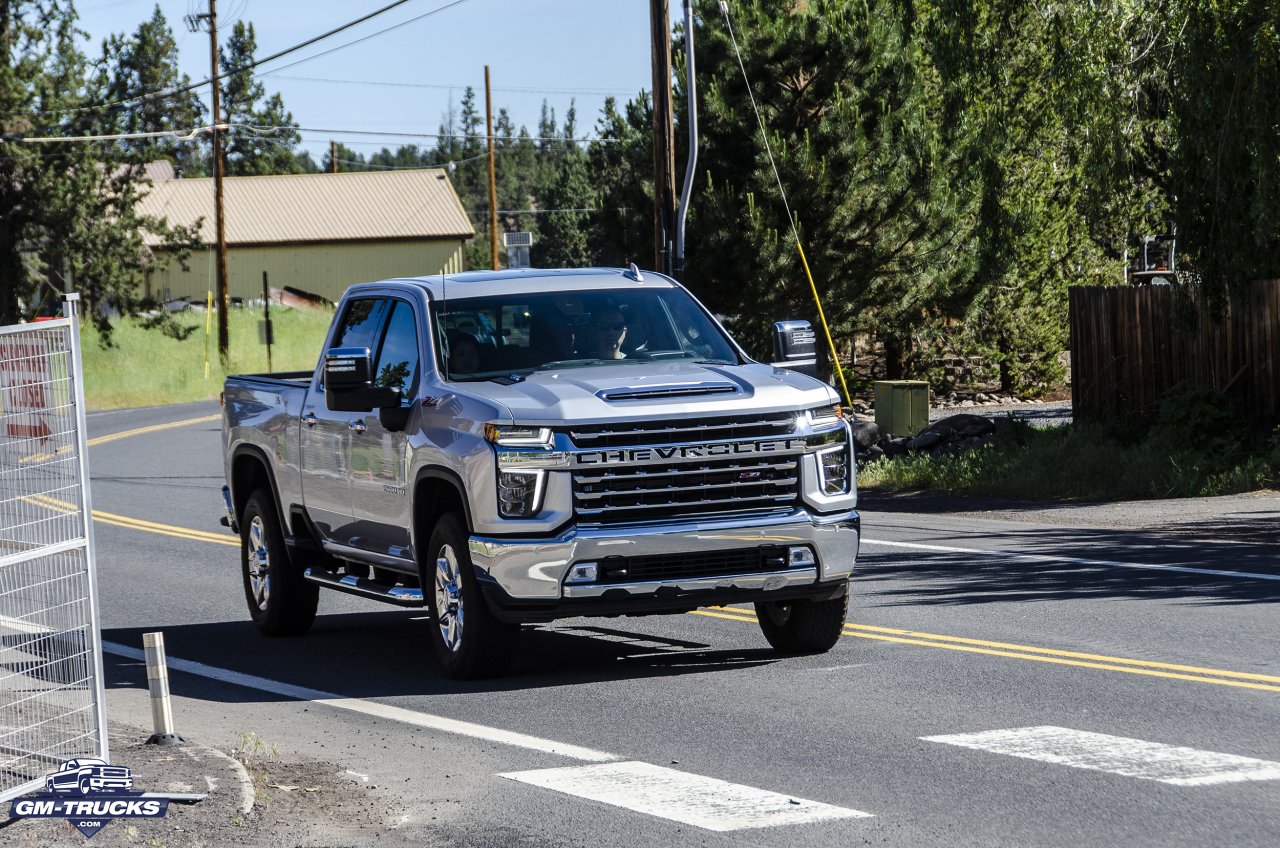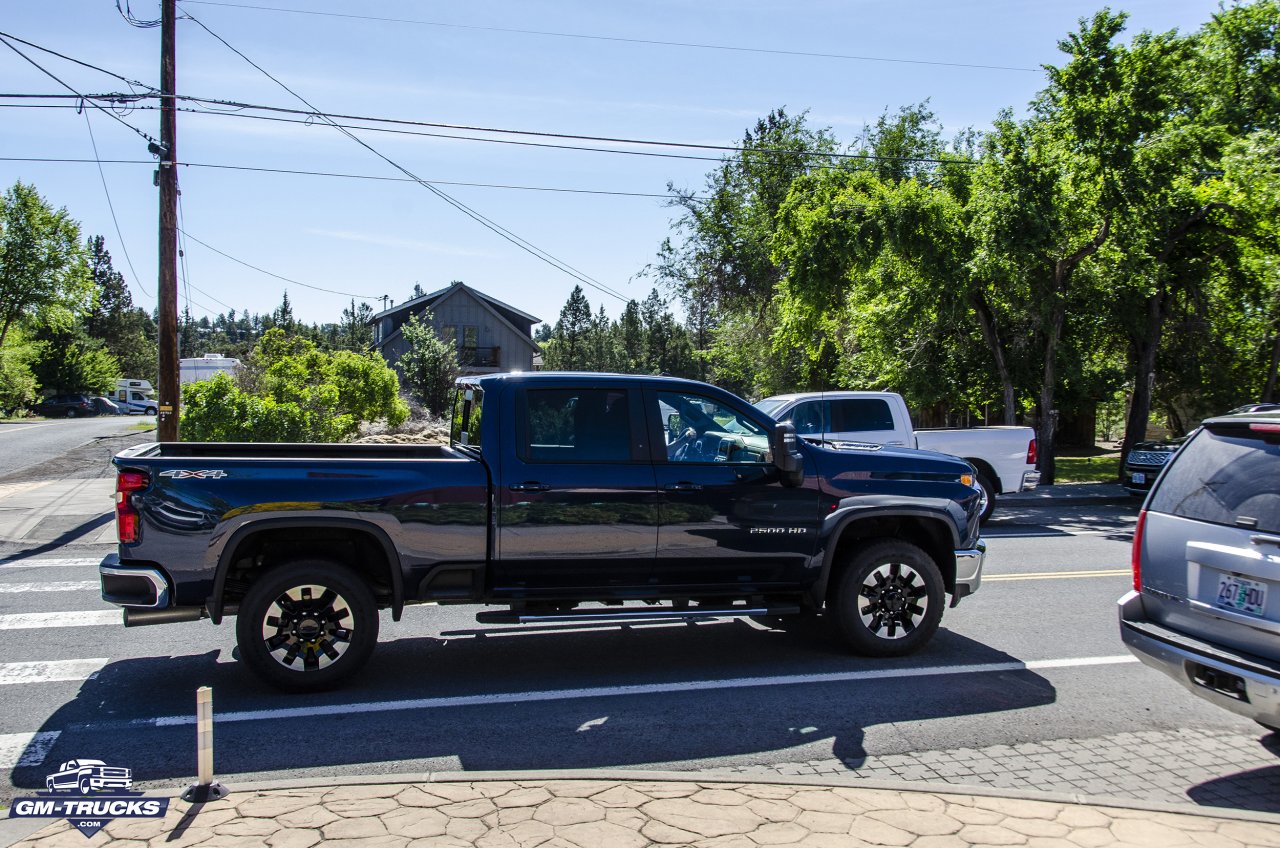Search the Community
Showing results for tags 'silverado hd'.
-
Thom Cannel: Article & Photos Zane Merva: Photos & Video GM-Trucks.com June 25th, 2019 By now you prospective 2020 Chevrolet Heavy Duty owners are over the Ho-Hum of our 2020 Silverado 3.0-liter story (we are totally Ho-Ho-Ho and Hmmm, can’t wait for a longer test!) and looking at the Alpha Dog, the 35,500-pound tow-rated Silverado Heavy Duty and its over 50 industry firsts including an updated diesel engine and all-new 6.6-liter gas engine. Let’s get to it. Where to start? With its amazing trailer towing features that include 15-view camera and ability to memorize the features of five different trailers? How about the Durabed with its class-leading cargo volume and all-steel construction with a plethora of cargo tie-downs? Maybe you’re gobsmacked by the corner and bed steps with, now, plenty of toe room and 500-pound weigh-holding capacity? Is it the power tailgate that remotely lifts or lowers? An ability to hold first gear while towing maximum weight? Or, is it all of these? Chevrolet states that Heavy Duty trucks are working vehicles, whether towing a gooseneck horse trailer or flatbed and whether gas or diesel-powered. They further tell us that, compared to light duty trucks where 84-percent are retail and 12-percent go to fleets, Heavy Duty buyers are 70-percent retail and 30-percent fleet. Further, Work Truck and Custom trucks make up the volume; LTZ and High Country capture an even larger share of the market for personal and dual use buyers, with mid-trim LT trucks straddling fleet and personal use. Hence the five available trim levels to suit the needs of every buyer. There is no mistaking that the 2500HD and 3500HD is kin to the 1500, yet only roof sheet metal is common. Everything about the new HD trucks was designed to be functional from larger grille to lower side-height bed, to improved box and bed steps. It’s massively bold with strong character lines, huge fender wells and functional hood scoop. Both the 2500HD and 3500HD are distinctive and clearly Chevrolet. For 2020, every frame is boxed and steel, there’s a model with built-in gooseneck cross-body reinforcements and bed holes, 4X4 models can option Autotrac two-speed electronic transfer case, the DEF tank is relocated inside the frame rails with the filler under the fuel door, plus a 10-segment DEF gauge measures content. A statistic to toss off at your microbrewery; within the total HD segment, 54-percent are Crew Cab diesels while within fleets, 62-percent are gas-powered, with 34-percent of fleets buying Crew Cabs and diesel power. And if you’re wondering where the 2020 Silverado HD you’d like to scope out on your dealer’s lot is hiding, Crew Cabs began delivery last week with Regular Cab, Double Cab and Duallies hitting the streets this fall. Restrain yourselves. Let’s now talk about the biggest reasons for owning a Heavy Duty Chevrolet (or GMC). It’s towing. And if you’ve noticed comments to our 15-camera article, there’s some passion about technology. Realistically, as many HD trucks are sold to new truck owners towing large RVs, anything that improves road safety is flat wonderful. If you further read Chevy’s research that says 12-percent of pickup drivers have gotten into a fight with their significant other over trailer hookup, you’ll understand executive chief engineer Tim Herrick’s comment that “We save marriages.” Having driven every truck segment from light duty to tractor-trailers we feel you. So, when research says a majority of drivers are stressed by towing, please offer them a 2020 Silverado sales brochure and a tissue (and save a tissue for yourselves ‘cause you might be exaggerating your tow-cool). So let’s dive deeper into the subject. Everyone has a hitch camera these days, with overlaid guidelines to put you within a few inches, front-to-back, of the ball. Chevy goes further with a selectable view that looks own over the ball. Even those who haven’t set a hitch in years—or never—can get within a quarter-inch of perfect. And an APB or automatic parking brake engages automatically so that when you lift off the brake pedal you don’t roll off the ball. Sticking with the non-pros and semi-pro haulers, there’s a checklist for your trailer, the ability to check the lights after connecting the trailer’s electrical system, a tow-haul reminder and VIN-specific labels for the trailer itself. If you option the smart trailer integration, which is designed to work with ASA Electronics iN∙Command® control system, you have control over trailer features like heat and air conditioning through the infotainment system or the myChevrolet mobile app. And nobody should turn down the ability to monitor trailer tire pressure and temperature. Blowouts are never convenient and most often low-pressure and highly temperature related, according to Michelin Tire Company. We found the 15-view system difficult to get used to during the first five minutes, particularly when backing; our mirror habits are embedded. Yet, simulating tight turns where we could see along both the tight and far side, pulling forward into a tight box, or backing (after a few tries), we really came to appreciate what the system could do. Then, on the highway with an 18,000-pound box trailer behind us, mirrors just didn’t cut it compared to the high-tech camera system. We were driving on twisting two-lane blacktop in mountain foothills. Using the entire camera tech set, particularly the ability to look out the back of the trailer, we could easily pick places to pull aside to let faster cars pass us. It took less than an hour to become a must-have feature. Later we towed a smaller skid-steer on a flatbed without the system and truly missed it despite using our slide-out mirrors fully extended. This naturally leads to the two engines offered in the 2020 Heavy Duty, first the 6.6-liter V-8 purpose-built gas engine that delivers 22-percent more torque than its predecessor. Now it delivers 401 horsepower and 464 lb-ft of torque. It’s mated to a six-speed automatic transmission. The 6.6L isn’t a just a 6-mm stroked 6.0L, rather it takes advantage of the Gen5 small block architecture and has a unique cast iron block with forged powdered-metal connecting rods and forged crankshaft. The most significant change is the addition of Direct Injection. It’s all new, an industry first for the heavy-duty market and new to GM trucks. Direct Injection allows a compression ratio of 10.8:1 Quoting Mike Kociba, a GM engineer and part of the Small Block team, “Our suite of changes allows us to hit class-leading gasoline engine torque, at 464 foot-pounds at a lower engine speed than the outgoing six-liter was optimized for. I'm proud of its 401 horsepower, which is SAE Certified; no games, it’s legitimate. Customers can have confidence they're going to tow whatever trailer they need.” Don’t forget the larger cooling fan and newly designed water pump. The pump drives the fan through a one-inch shaft with unique bearing design to handle greatly increased thrust loads. Plus, the oil pump is now has variable output, so there’s less parasitic losses. The 6.6L engine features an aluminum oil pan, nylon 6-6 air intake, and stainless steel exhaust manifolds unique for the Heavy Duty market. Like related light duty Gen 5 motors, this motor has variable dual-equal valve actuation, massive Gen5 valves and uses an actuator that’s mounted to the front cover to control intake and exhaust valves. The new block features inter-bore cooling, that is, coolant flows through Siamesed bores, notably in the upper bores where there’s a tendency to generate higher temperatures. “Small engines with turbochargers allow them peak torque off idle,” Mike told us, “but for heavy duty we don't want that complexity. For the Heavy Duty segment we (General Motors) have durability requirements—Global Engine Durability—that are unique stringent. We know our customers and why we focus on durability. If they can't use their truck today, they might not get paid.” When towing a heavy load, we loved the diesel’s engine braking capability. What about the gas engine? In Tow-Haul, up-speeds caused by downhill driving—together with intelligence based on throttle position—the powertrain produced seamless downshifts. It’s not quite the same as engine braking, but the trailer was “only” 12,000 pounds. Regardless, it was a comforting addition to stress-free towing. The six-speed transmission used for 2020 Heavy Duty GM trucks is an updated 6L90 with an uprated torque converter and clutch pack. According to GM engineer Rich Mardeusz those changes were simple. When it came to the torque converter, things changed. “We looked at the components from a heavy-duty diesel torque converter and a high-output gas torque converter and then took the torque-carrying components from the diesel and married them to the spring and damping components from the gasoline torque converter. That’s what was needed to accommodate the approximate 22 percent across-the-board torque increase.” Those changes also damp out firing frequencies from the gasoline V-8 engine, making the powertrain smoother. Since a majority of buyers opt for the diesel engine, let’s look at that. Also displacing 6.6-liters, the Duramax turbo-diesel makes 445 horsepower and 910 lb-ft of torque. It’s coupled to a 10-speed Allison transmission. There were minimal changes to the engine for 2020. They include a 28-inch fan for cooling; upgraded oil cooler—now 19 plates instead of 14 and the cylinder head gasket was improved. Engine brake capacity is greater by 14-percent and while there’s a button for manual activation, while in Tow-Haul mode engine braking is automatically activated at certain RPMs. It’s Chevrolet keeping you safe. Thus, under the new control system the powertrain will recognize any need for the engine brake and activate automatically. For instance in driving down hill and forgetting to shift, the higher RPM means automatic activation. We did experience this with the18,000 pound box trailer and it is amazingly transparent and surprisingly quiet. You don’t have to downshift on modest hills, as the system will totally keep you at, or near your desired speed. Of course you may have to use a bit of smooth brake application if the grade is longer, or steeper. For really steep downhilling Plus-Minus buttons on the column-mounted shifter initiate gear changes. We’re not huge fans of the buttons as the steering wheel obscures their location and make it a bit fumbly to slide your thumb into position. A really important feature for 2020, diesel models add an engine after-run feature. Should you tow up a grade and park for dinner without a cool-down, the truck will do it for you. Run time is limited by temperature and shutdown is equally automatic. Because of the Allison/GM 10-speed transmission used for 2020, the powertrain required a complete recalibration. There are several positive results, according to David Ames, GM assistant chief engineer and Allison liaison. “Emissions have been improved and fine-tuned to maintain the best efficiency the transmission can offer to our customers.” It also has a fully warranted chain-driven engine-speed PTO available from the factory. The new 10-speed’s torque converter has a lock-up clutch that is unique as it will lock up in first gear, even under max loads. So, if you're pulling 35,500 pounds, you can do a first gear launch and lock up right away, which helps get rid of heat. We asked David why this is important. “Normally in first gear you're under high torque and generating a lot of heat, which puts a lot of demand on the cooling system. Locking up gets rid of that heat. Also, the new transmission has a lower 4.5:1 first gear with four planetary gear sets and six clutches. We noticed the low gear and ten speeds on launches and while pulling the box trailer on the highway. Often in hilly driving you're downshifting to save brakes; with ten gears we held the right speed and best RPM, particularly with automatic engine braking. We did drive a Silverado 3500HD dually at max capacity; 35,500 pounds on a closed course: our US Army CDL permit has lapsed. The claim of off-the-line torque is spot on. What was most interesting was the 3500’s ability to resist being pushed about on turns and we did several random serpentine loops to see if we could find any significant push? Nope. Later, with “only” 17,000 pounds behind us we finally found a bit of trailer push, which required a deeply rutted dirt road and an off camber turn. Nothing the truck couldn’t handle, even with a journalist behind the wheel. Many of us wondered why the different transmissions for Heavy Duty trucks, why not just the Allison ten? We asked and, while suspecting that plant capacity utilization and raw costs have something to do with it, were told by Vincenzo Verino, the 3.0L Duramax global chief engineer “It’s really about what the transmission brings to the engine itself. With a wider torque band, the gas engine is well-matched to a six-speed, while the narrower torque band of the Duramax is better suited to a 10-speed.” In the battle for Heavy Duty supremacy, big numbers are thrown around to convince potential buyers of worth and value. We found these slides from Chevrolet’s presentation compelling, showing Chevrolet doesn’t always have the biggest power numbers, yet can deliver more real world competency than competitors. Faster to 60 with better towing capability, we’ll take that over a bigger number any day. And Chevrolet says every diesel dually will tow more than 30,000 pounds the 2500HD with 6.6L gas engine has a tow capacity of 17,400 pounds, up 18-percent, that’s good regardless altitude. There is much, much more to tell in future stories, like the no-cut removable fascia for winter snow plow installation and the covered fender-mounted engine heater outlet, use reports of the up-down power tailgate and the bed’s 12 fixed and 9 moveable tie-downs. There’s details on improved axles, locking rear differential, beefed-up prop shaft and 12-inch ring gear, stronger U-joints, class-exclusive SLA front suspension (“mandating a solid front axle for HD trucks isn’t a thing” according to the chief engineer Tim Herrick) and the list goes on. We expect to write several more stories about the new trucks, each specific to how you’d use the truck and with even more details. We have only scratched the surface.
- 12 replies
-
- 2020
- 2020 chevrolet silverado hd
- (and 19 more)
-
Zane Merva Executive Editor / Publisher - GM-Trucks.com June 21st, 2019 We recently had a chance to check out the all new Silverado HD. The 2020 Silverado HD has an optional 8 camera system to help aid in towing your trailer. We get a full walk through of the various views and camera angles.
-
My new truck has cameras all over it. Front, side, rear, top. I figured out how to remove the tailgate, even made a short UTube video to help others, but after removing it, I found out that the camera system does not work. I still wanted the front, side, and top cameras to work with the tailgate off. Has anybody else encountered this? Figured out how to keep them working with the tailgate off?
-
Thom Cannell Contributor, GM-Trucks.com March 7th, 2019 Heavy Duty trucks mirror the contest for market domination in light duty trucks. This year both GM and Ford announced significant upgrades to the engines powering their all new 2500 and 3500 HD trucks as each company upgraded their diesel engine, and delivered new gas engines. At GM, the launch event centered on Chevrolet, who brought in truck writers from every segment—popular to fleet management—to Flint, Michigan’s Flint Truck Plant. Flint is the original home of General Motors trucks and the spiritual and historical home of the UAW. So, Flint Truck Plant is receiving an all-new facility constructed and designed for just HD trucks, with the former truck assembly areas destined for warehousing and future projects. New L8T 6.6-Liter Gas Engine We first spoke to Mike Kociba, a GM engineer and part of the Small Block team to learn about the new 6.6-liter V-8 engine we'd been anticipating. Mike told us the new motor “is a marriage of the six-liter it replaces and an upgrade in technology levels to Gen 5 architecture.” A careful look will disclose similarities in key areas where GM has maximized their experience with the six-liter’s durability and improvements in performance levels derived from Gen 5 architecture. “Specifically, new here is the gray cast-iron block which is unique for this application, hyper-eutectic purpose-built pistons for this application and heavy-duty requirements, forged powdered-metal connecting rods, and a forged steel crankshaft,” Mike continued. The most significant change is the addition of Direct Injection. It’s all new, an industry first for the heavy-duty market and new to GM trucks. “When we added DI, we took the roughly 400 KPa fuel pressure from the low-pressure pump and dialed it up to roughly about 15 mPa for engine operation under key conditions,” Mike continued. “That allows us to increase compression ratio, now 10.8:1 using regular fuel. Without DI you're not going to hit those numbers without losing a lot of spark efficiency. With those additions, and the six millimeter longer stroke, that gets us up to 6.6-liters.” “That suite of changes allows us to hit class-leading gasoline engine torque, at 464 foot-pounds at a lower engine speed than the outgoing six-liter was optimized for. I'm proud of its 401 horsepower, which is SAE Certified, no games, legitimate. This (engine) is purpose-built to crank out those numbers day, after day, after day with no compromise in durability. Customers can have confidence they're going to pull, tow whatever trailer you need.” There are other new features like an all-new water pump and a massive cooling fan to meet the demands of the HD customer base. New is how the water pump drives the fan through a one-inch shaft using purpose-built bearings to handle loads. Another first for HD is a variable-output oil pump. “No mater what the severe operating condition is for the customer, the pump is capable of dialing in more, or less oil pressure regardless the requirement. The engine features an aluminum oil pan, nylon 6-6 air intake, and stainless steel exhaust manifolds unique for the Heavy Duty market. That’s because HD market has specific requirements for (fuel) enrichment and these stainless manifolds will meet those requirements. “We have variable dual-equal valve actuation, like on light duty, where intake and exhaust are phased together and controlled through the actuator on the front cover. It's chain driven for accessories.” GM designed this engine specifically for upcoming standards for particulates and NOx emissions standards. “With this architecture we're not just making power and torque, but improved emissions and improved efficiency.” Mike continued. We noted the massive valves, which Mike said are common with Gen 5 architecture for valve layout and their pushrod technology. “That's how we get this compact shape. When you compare the size of the two engines, they're similar, which is due to the common 4.4-inch bore spacing.” A unique feature of the new engine is inter-bore cooling. Coolant flows between the Siamesed bores, notably in the upper bores where there’s a tendency to generate higher temperatures. “For two-valve technology of course you've got the spark plug, and the fuel injector, splayed outside. To avoid heat, we have the coil mounted directly on the rocker cover and the boot mounted next to the manifold with industry-standard individual coils for each cylinder.” This is great stuff, we though, but engine development isn’t cheap. So, why a new 6.6-liter when the 6-liter was doing well? “We needed to improve to Gen 5 level of technology to be sure (the engine) is capable of delivering on durability requirements. Customers love the convenience of gas, but if you look at the market—for instance trailers with more gadgets and slide-outs—everything is getting heavier. Customers want to be sure they can tow with confidence, no compromises, whether it's fuel economy, power, torque, emissions, efficiency, they don't want to pull up to their neighbor and have to make excuses. That's what we targeted. No compromises. With the significant technology we put into this engine, it makes segment-leading torque without compromising efficiency or emissions. Peak torque is at 4,000 rpm, 400 rpm lower than the 6.0-liter. Three things enable the new 6.6-liter's better power output. Direct injection (DI) allows us a higher compression ratio; longer stroke is good for increased torque (but not as good for horsepower as piston speeds are high) and for heavy-duty application where you need torque everywhere it’s why we focused on a longer stroke to get to 6.6-liter displacement. Those changes enabled us to broaden the torque curve, which is up 20% everywhere, for greater work potential.” We thanked Mike and asked if we’d missed anything. “Small engines with turbochargers allow them peak torque off idle, but for heavy duty we don't want that complexity. For the Heavy Duty segment we (General Motors) have durability requirements—Global Engine Durability—that are unique and very long and stringent requirements. We know customers need 401 horsepower and 464 lb.-ft. of torque today, tomorrow, and every day for years to come with no compromise in durability. We know our customers and, if they can't use their truck today, they might not get paid. That's why we focus on durability.” Brand New HD 6-Speed Transmission With that in mind, we next spoke to the systems chief engineer for six-speed FWD and RWD transmissions Rich Mardeusz. More power and more torque tend to break an older transmission. So, we wanted to know what changes had been made to the new transmission to carry the additional torque. “We started with the 6L90 that's in the current HD vehicles and full-sized vans (and ZL-1 Camaro and CTS-V), received the horsepower and torque curves from the engine engineering teams and then performed an analysis of all mechanical components from front to back,” Rich said. General Motors uses specific simulation tools for different parts. “For instance, we have a "gear damage analysis tool" for analyzing the gear set and how much damage it may receive over the life of the vehicle,” Rich told us. The result was a need to improve the torque converter and the clutch pack, which needed to be more robust to accommodate the greater power output of the upgraded 6.6-liter V-8 engine. From a clutch pack standpoint, changes were simple, according to the engineer, as there was enough room in the case to add a clutch and one backing plate to each of the clutch packs to handle additional power. When it came to the torque converter, things changed. “We looked at the components from a heavy-duty diesel torque converter and a high-output gas torque converter and then took the torque-carrying components from the diesel and married them to the spring and damping components from the gasoline torque converter. That’s what was needed to accommodate the approximate 22 percent across-the-board torque increase.” So, the new torque converter can A) handle the added torque of the new engine and B) damp out the firing frequencies from the gasoline engine, which are significantly different from a diesel engine. All of the shafting and gears were able to handle the torque. Interestingly, there is no dipstick. GM has the confidence to eliminate it, and only change fluid at suggest intervals of approximately 100,000 miles, more often for those who mostly tow, or drive over mountains with full loads. Another surprise, the transmission uses GM-spec Dexron VI fluid, GMs standard since 2005, as they found no reason to change. 2019 L5P Duramax 6.6-Liter Once we’d completed our gas powertrain interviews, we turned to the diesel side of Heavy Duty. We spoke to Max Sala, whose Italian accent tipped us to an affiliation with GM’s diesel engine center of excellence in Turin, Italy. Max said that their objective for the new Silverado HD was to increase towing capacity and ensure functionality with the new Allison/GM transmission. Remember, the Duramax 6.6L Turbo-Diesel V-8 engine makes 445 hp. and 910 lb-ft of torque. “We added a bigger fan now 28-inches, a bigger oil cooler that is upgraded from 14 plates to 19 plates, and we fine-tuned the cylinder head gasket” Next up were improvements to the engine-brake capacity, taking into consideration towing capacity. “It’s better by 14-percent and we introduced smart activation of the engine brake,” Max continued, “There's still a button for manual activation, but for safety there's automatic activation at certain RPMs.” Under the new control system, the powertrain will recognize any need for the engine brake and activate automatically. For instance in driving down hill and forgetting to shift, the higher RPM means automatic activation. “With that, we have better after-run strategy. Every time you tow uphill, temps rise and you have a message to cool the engine when stopping. If, by chance you forget and close the door, the system cooling system activates automatically for up to 15 minutes to cool the engine for reliability.” That isn’t the end of changes, as the engine has been completely recalibrated to match the new 10-speed Allison transmission. “Emissions have been improved and fine-tuned to maintain the best efficiency the transmission can offer to our customers.” With these changes, most importantly, Chevrolet says they are now capable of delivering full torque at any time, in any gear, and that they have done everything to the engine, transmission, driveline, drive shaft and frame to improve strength and durability. “What's important is how safe (the new HD trucks) will be and how comfortable it will be for our customers to drive these huge trailers up, and down hills.” Max concluded. Allison transmissions have gained a peerless reputation for strength and durability. Adding a 10-speed transmission branded with the Allison name is a great choice. David Ames, now GM assistant chief engineer on the Allison transmission and liaison with Allison, is a former Allison engineer. A natural fit. The 10-speed is a collaborative effort with joint development of the analysis, engineering, as well as testing. So, testing was performed at Allison and at GM, each with their own set of rules and test regimes. “We go back and forth”, David told us. “Today we have a ratio-span of five and this transmission has a span of 7.2, so the new 10-speed provides both more overdrive and a lower first gear.” We asked about the projects’ starting point. “We (at GM) come out with a "here's what we're looking for" and we begin an internal development contract. It was a pretty clean sheet of paper. So, the controls on the bottom are from a smaller 10-speed, some pieces and parts, but not the entire controls package. For the most part, it's all new to handle the increased power and much larger torque. We collaborated with Allison on this transmission (GM does have a 10-speed transmission of its own) which made it necessary to meet their (Allison) design requirements, their analysis requirements, their engineering requirements, as well as our own. It's a very compact transmission. If you had a 6-speed for comparison, this more dense, more compact and solid to get ten speeds into a package that would still fit nicely into the vehicle and not take up too much space,” David continued. This transmission’s torque converter has a lock-up clutch and is unique in that it will lock up in first gear, even under max loads. So, if you're pulling 33,500 pounds, you can do a first gear launch and lock up right away, which helps get rid of heat. We asked David why this is important. “Normally in first gear you're under high torque and generating a lot of heat, which puts a lot of demand on the cooling system. Locking up gets rid of that heat and the 7.2 ratio gives you a lower first gear. For instance, the six-speed uses a 3.1 first gear and the new transmission has a much lower 4.5 first gear. It's got four planetary gear sets, six clutches and the main place you'll notice the ten speeds, not only in launches and driving with heavier loads—it's very smooth—is going down a grade. Often you're trying to downshift to save brakes and having ten gears you can usually hold the right speed and not feel like you're running over the car in front of you, tapping the brakes or going too slow.” “Also, we built in the first OEM PTO option. Note that the chain drive to the PTO is engine-speed driven rather than turbine-speed driven, which is important to many commercial customers, and it’s quieter drive than gear driven systems.” We asked David for an overview of the combined Duramax-Allison package. “For those who need it, it’s a nice package, one we're very proud of because of the outstanding durability. I think we're going to do a better job of putting power to the road than anybody out there. Whatever torque the engine is putting out, it's getting to the road in an accurate way. I think this transmission will be far more durable than people need it to be. Four-five years from now people will understand how durable it is.”
-
Hey all I was wanting to do a 2500 front end conversion on my 2018 1500 Silverado. Has anyone done this to their truck if so whats the process and what is required? I'll take any advice i can get as im only looking to change the hood, grill, headlights, and bumper obviously. Any help would be greatly appreciated!
- 7 replies
-
- Conversion
- Swap
-
(and 4 more)
Tagged with:
-
Okay, so we all know that what's in the published specs is rarely the real payload of the truck. For those of you lucky enough to have your 2020 HDs delivered already, could you please share what your configuration and trim level are, and what does the door sticker say your payload and tow rating are?
-
Hey everyone, I just wanted to make sure any of you 2020 guys saw two videos we recently put together on the 2020 Silverado HD. More to come as the embargo breaks on what we can say next week. Enjoy and make sure to like and subscribe to our channel, PLEASE.
- 10 replies
-
- 1
-

-
Thom Cannell Contributor, GM-Trucks.com February 13th, 2019 Flint, Michigan, was cold on Tuesday, gray with a winter sleet warning in the forecast. It was a perfect day to launch Chevrolet’s all-new 2020 Silverado Heavy Duty truck in the face of the just-launched Ford product and almost-here RAM. Flint is where the truck will be built in a brand new plant that’s part of the 159 acre, 3.3 million square foot Flint Assembly plant. In an eerily quiet staging area, first plant manager Michael Perez talked about the 3,000-strong work force and the plant’s longevity, and the recent 1.5 billion dollar investment. Flint is GM’s longest continuously operating assembly plant, having produced more than 13-million vehicles since opening in 1947. Interestingly, the first 300 production Corvettes came from Flint in 1953. Then Silverado HD chief engineer Jaclyn McQuaid described its advanced trailer tow features, the fully boxed High Strength Steel frame, and its two new powertrains. She spoke about a tow rating minimum of 33,000 pounds for every dually, not just the 35,500 maximum for a specific option set. That maximum tow rating is up 52-percent! Mark Reuss, president of GM described their truck strategy and last year’s 973,000 truck sales. He projected strong earnings for 2019, now that the three-truck strategy is in effect—Colorado, Silverado and Silverado HD, plus Medium Duty 4-5-6 series trucks. He also commented on, but gave no details on the 3.0-liter Duramax diesel engine for light-duty trucks. Damn! Mark was followed by chief designer Rich Scheer, who outlined exterior and interior changes like the corner-step and bed step, same-height bed rails, integrated block heater outlet, and easy fitment to snow plows. “We knew if we could pull off something this dramatic, nobody would mistake our Heavy Duty for a Light Duty -- and that would be our competitive advantage.” Rich then went for a Trim Walk, from Work, to Custom, to LT and chrome, the LTZ with more chrome and LED headlights, and finally High Country with its body-colored bumpers and 20-inch wheels. With the talking complete, these are the things that grabbed our attention: first, two new engines and two new transmissions. Each powertrain is based, somewhat, on existing products. We’d been waiting for the new gas engine in particular. Based on the 6.0-liter V-8 small block, its longer stroke ups displacement to 6.6-liters with a power output of 401 horsepower and 455 lb.-ft of torque at 4,000 rpm thanks to Direct Injection. It offers 18-percent greater tow capacity. We’ll have a complete photo essay after the Chicago Auto Show, which we’re currently attending. The diesel, all 910 torques of it, is mated to an Allison® transmission boasting ten speeds; a very low first gear and several overdrive gears. The main benefit of having ten speeds is keeping diesel engine RPM in the best band for torque and for perfect no-brake downhilling. Again, more after Chicago. Except for one note, because of the massive 12-inch ring gear and larger prop shaft and axles, Chevy (and of course GMC) promise every single foot-pound of torque can be applied in first gear. Even that lower first gear. The Introduction & Reveal When we stepped into our meeting room, several partly assembled trucks were in mid-test form. Using coordinate measuring machines that index to established hard points, precise measurement of how individual parts fit, and how the whole assembly conforms to engineering standards is established. This hanger-sized area would be for temporary storage. On this Tuesday, every truck writer in the USA sat alongside engineers, executives and teammates. Michael Perez, plant manager delivered a history lesson on the oldest of GM’s plants and the workforce represented by UAW Local 598 that will build GM’s Heavy Duty trucks in volume, starting in summer. Mark Reuss, GM president, spoke about Chevrolet’s five-truck strategy, how General Motors sold more trucks than anyone last year, and how the company expects to continue improving its products. (Now, if only there were some extra funds for interiors…) Jaclyn McQuaid is the chief engineer for Heavy Duty, and she produced two bare chassis to extol the boxed High Strength Steel-y goodness thereof. Most interesting is the claim that each Heavy Duty truck can apply 100-percent of its available torque in first gear without turning the driveshaft into scrap. She also debuted the new gas engine, which we had not expected. The upgraded Duramax 6.6-liter V-8 mates to an Alison transmission, a segment exclusive, and the powertrain offers an optional, warranted, PTO, another exclusive. Frames are available with built-in gooseneck cross-body reinforcements and bed holes from the factory, saving extra costs and possible fitment misfits. Another option is an Autotrac two-speed transfer case for 4X4 models. It’s fully electronically activated. One sought-after upgrade for diesel trucks is easier access to DEF, and a way to monitor DEF quantities. The new Silverado HD encloses the DEF filler behind the fuel door and provides a DEF quantity monitor. (This is welcome, needed, but hardly novel.) If you need a gooseneck setup, GM offers it from the factory. It includes a bed already perforated during production, so is fully coated on all surfaces for less rust potential. Closer view of the diesel powertrain, with the PTO option. GM’s new small-block 6.6-liter V-8. The tall intake manifold is made from Nylon 6-6, and we’ll provide more details soon. Even the gas engine, which does run on 87 Octane fuel, offers a factory PTO. One of the novel options is smart trailer integration, which is designed to work with ASA Electronics iN∙Command® control system. This offers control over trailer features like heat and air conditioning. You control it from the dash, or your myChevrolet mobile app. We mentioned the designed-in easier fitment for snowplows. No cutting required. This Cougar trailer is the one monitored in our infotainment center photos. There’s nothing like proving your truck can pull a large trailer. However, note the new towing mirrors. They slide in-out to provide coverage for trailers that don’t have the transparent trailer view option. Some venues have greeters. We had a new Silverado to welcome us. The Flint Plant Tour Largely robotic, the plant uses JIT or Just In Time parts that arrive in reusable fixtures. We weren’t told how many robots there are, but 3,000 people make the trucks. Everything possible is done to prevent scratches and dents. While it would seem that once a part is designed and the stamping die constructed, the job is over. Not so. Constant measurement is part of the process. Using multiple part profiles, this video-enabled dimensional test device looks at minute, hair-thin deviations from specification. Once is an aberration, but several would require intervention in production. At start-up, every part is tested. Thereafter, a statistical sample will be used. Remember when we said beds were produced for fifth-wheel or gooseneck applications? These are raw parts in several bed lengths, prior to welding into complete beds. Parts arrive from GM’s attached metal stamping plant on AGVs, Automated Guided Vehicles. Laser-guided (look at the up-looking towers), they flow throughout the plant on designated paths. Smaller parts are tugged throughout the plant by AGV tugs. They operate in strict lanes. Partly assembled bodies and beds head towards the paint shop to be immersed in protective chemistry, prior to the paint shop’s base and clear coat application. Wondering about the upside-down tailgate? It’s so the anti-corrosion primary coating can drain out through what will be bed-top mounting holes.
- 15 replies
-
- 1
-

-
- 2020 silverado hd
- silverado hd
- (and 6 more)
-
Zane Merva Executive Editor / Publisher - GM-Trucks.com June 21st, 2019 The 2020 Chevrolet #SilveradoHD is draped with an all new design that is totally unique from its light-duty 1500 sibling. Take a walk through with us and 2020 Silverado Lead Exterior Designer Brian Izard to learn more about the 2020 Silverado HD's design and features.






















